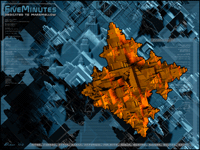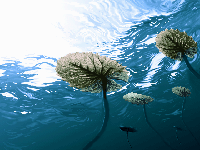The term “demo” first came up in the 80´s, when
some hackers decided not to work on software cracking anymore, but to
create intros. The name “demo” became known rather fast and soon developed
an own community: the demo scene had emerged as a cross national
subculture.
Until now, the demo scene has been growing
continously and drawn an own audience. So called demo parties are major
events that bring together the whole scene, celebrating new achievements
and matching in competitions (“compos” - a complex system of contests that
are subdivided by categories/ “restrictions”) as well as organising new
projects and get in touch with each other. The demo scene´s most important
medium are diskmags. Electronic magazines with quality content, these disk
mags were distributed as disks. By now, more and more publishing is being
done via internet.

On the basis of both the different hardware platforms (C64,
Amiga, Atari, Windows PC etc.) and the “restrictions”, the scene in the
meantime got into a state of differenciating the distinct segments (in
each of which, various aspects are focused on, such as programming,
graphics, sound/ music etc.). As displayed on the pictures you find on
this site, the band width of the different aesthetics is rather great:
techno-like imagery appears just as often as adventure game graphics,
rather naive, object-focussed or retrospective design.
What keeps
the scene together is a commonly accepted philosophy: no matter what
segment, what field a “scener” (a member of the demo scene) is working in,
the main goal is to bring out the best from the machines by using one´s
own creativity and competency - naturally, abstaining from modern hard-
and software.
 Excursion: the oldschool
Excursion: the oldschool The oldschool is a
subscene of the demo scene. Its members still use the computers that were
up to date at the time of the first releases of demos - that is, the C64,
Amigas and Atari. Furthermore, even old data formats for music and
graphics are applied. Graphic acceleration and renderengines (nowadays
essential part of of any graphic chip) are proscribed and considered
“lame”. Refraining from any kind of facilitation that is offered by new
equipment is what distinguishes the oldschool scene.
The oldschool
scene claims that by imposing strict limitations, creativity is
encouraged. Special effects can only be generated by means of high skills
in programming, not of high quality equipment. Thus, it is beyond all
question (at least for the oldschoolers themselves) that the best
programmers can be found among the "oldschoolers".
Apart from a
certain liability for “oldschool” design, the nimbus of simplicity and
intelligibility - the possibility to understand and control - is what
above all characterises the dedication for machines from the 80´s (and, of
course, some kind of nostalgia or romantic childhood memories of one´s
first computer experiences). There is no doubt that the special attraction
of the oldschool scene consists of using exactly those machines to create
impressive demos.
Todays PC demos Looking at a
current PC demo (e.g. “FR08” by “Farbrausch”, a very famous one), it
becomes clear that such a piece is not produced by only one person. To
meet the requirements of the scene´s new standards, skills are necessary
that definitely exceed the capabilites of an ”ordinary” user. This applies
accordingly to the sound- and graphical field - professionality and
organisation are becoming more and more important.
Specialists are
in demand: At least, one graphic designer, one musician and one programmer
(coder) are needed to realise a big projects that meets up-to-date
standards. Yet, many groups consist of even more members: “Farbrausch” for
instance has 21 (coder, graphic designers, musicians, sound designers, 3-D
experts and hardware operators).
In general, it is the programmer
(coder) who is in charge of organising the whole group. He keeps in touch
with the single members (or recruits others) and spreads “group news”.
Thus, he is finally responsible for the demo´s realisation.
 Communication & organisation
Communication & organisation Since the
beginning of the demo scene, it is not only the amount of organisation
that has continously grown, but also the time the making of a demo
requires. The way of communication changed as well: while in earlier days,
information was exchanged via mail or telephone, nowadays, after the
entering of the internet, email and chat and later the WWW have simplified
the communication between global networks. IRC sessions or email lists now
serve as a “space” to talk about ideas and problems as well as the
development of new projects.
Once a demo is made up, someone has
to take care of the distribution (the “trader”). This happens on demo
parties, by circulating the demo to other traders. Meanwhile, demos are
distributed via internet as well.

